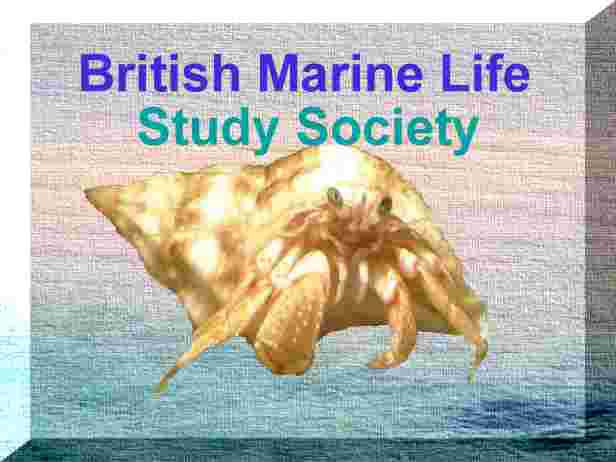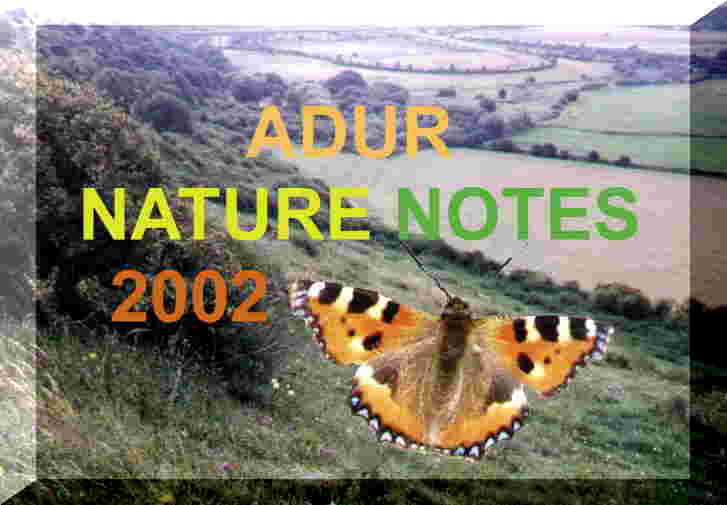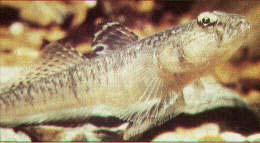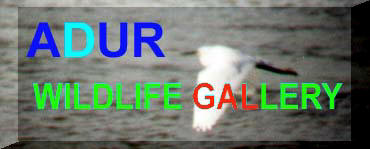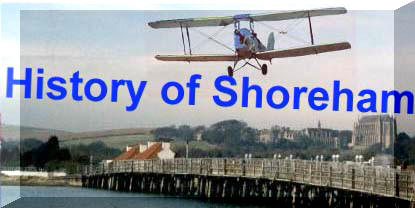
|
NEWS BULLETIN FOR THE ADUR VALLEY |
 |
| LOCAL
ORGANISATIONS |
| LOCAL RESIDENTS PAGE |
| Adur Flood Plain |
| Chalk Downs |
| Coastal Fringe |
| Intertidal (Seashore) |
| Nature
Notes for
Lancing Ring |
| River Adur Estuary |
| River Adur |
| Sea (off Sussex) |
| Town & Gardens |
| Widewater Lagoon |
| AREA MAP |
| Shermanbury (Adur Valley) |
| WSCC LIBRARY |
|
|

This is the first published
Electronic Newspaper for
Shoreham-by-Sea and the
Adur Valley & District, West Sussex, England
Local News
31 August 2002 & 1 September 200211:30 am 5:00 pmBATTLE OF BRITAIN AIR SHOW
at Shoreham Airport
Please send any comments to: Andy Horton
Glaucus@hotmail.com
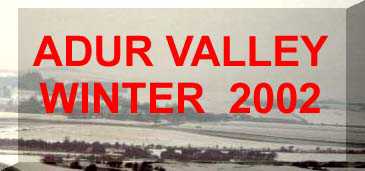 |
 |
 |
 |
Wildlife Notes
Ray Hamblett's Mill Hill web page (with photographs of orchids and other wild plants)
18 August 2002
A Wasp Spider, Argiope bruennichi, was spotted on Mill Hill. This a distinctive European continental species that has been spreading in the south-east. It was probably an ovigerous female. This spider has been found in southern England since the 1990's.
Butterfly List16 August 2002
A walk on the bridleway from the north side of Slonk Hill to Southwick Hill (TQ 225 070 - TQ 225 078) revealed the first Clouded Yellow Butterflies (8+) since 2000. They were flying around rapidly and would not settle. Unlike the Small Tortoiseshells (100+) which were everywhere settling on Ragwort and the bridleway. Most were brightly coloured, but there some faded ones as well. The Painted Ladies (30+) preferred the Greater Knapweed. Wall Browns (40+) preferred to settle on bare areas of chalk but made fleeting visits to Hardheads. Gatekeepers (25+), Small Whites (15+), Meadow Browns (15+) and at least one Red Admiral completed the butterfly list.
I disturbed a female Sparrowhawk on a fence post, (near some bushes with many small brown birds), which glided magnificently at at a low level across the open field.
15 August 2002
On a hot (25° C) and humid (82%) day, I made a quick visit to Mill Hill. On a small patch of the open meadows (TQ 212 073) the butterfly count for an area of 20 square metres was high and the following species were recorded in 15 minutes:

Chalkhill Blue (60+)
Meadow Brown (35+)
Small Tortoiseshell (20+)
Painted Lady (15+)
Wall Brown (one)
Large Skipper (one)
Common Blue (one)
The Chalkhill Blue Butterflies were nectaring on Round-headed Rampion, Greater Knapweed and Hardheads. The Small Tortoiseshells were overlooked in passing, but when I stopped they appeared very colourful and frequent, feeding on the occasional Ragwort flower.
In the scrub and longer grasses (TQ 211 076), the Gatekeeper Butterfly was surprisingly few in number and there were a handful, possibly many more Common Blues, the females with orange markings on their upper wings, feeding on grasses. Meadow Browns were everywhere.
In the other meadows, there were additional numbers of Chalkhill Blues, Meadow Browns and Painted Ladies.
Adur Butterflies
Adonis Blues and Common Blues Identification Tips
South Downs ButterfliesSkylarks were disturbed in the long grasses.
A large (8 cm diameter) fungus was growing on a tree stump on the east side near the bottom of the road leading to Mill Hill. The species has not yet been identified.14 August 2002
Widewater Lagoon was very full of water for August which could be explained by the heavy rainfall of the last few days which caused flooding in some places. The high tide of 6.1 metres (WXTide Table) occurred at 4.27 pm BST and the air bubbles shooting up through the cracks in the alluvium floor of the lagoon began one hour before the high tide. They occurred as a steady stream of small bubbles and sometimes as large less frequent bubbles and these bubble points occurred more often in the shallow water but also could be seen at the surface in water that was two metres deep. The conjecture is that this is seawater being forced into the lagoon through the shingle bank and the bubbling only occurs on tides of over 6 metres in height.
At 3.10 pm I saw some air bubbles in the area approx 200 metres west of main ridge and spreading a futher 100 metres west. There must have been at least 100 sets of bubbles! At least six had water rising at least 25 mm over the level of the Widewater. At this time there were no other areas showing this effect.
At 5.00 pm I then witnessed the same again this time some 200 metres east of the bridge and extending another 50 metres east. The bubble form was less pronounced than the previous lot.Supplementary Report by Trevor Nicholson
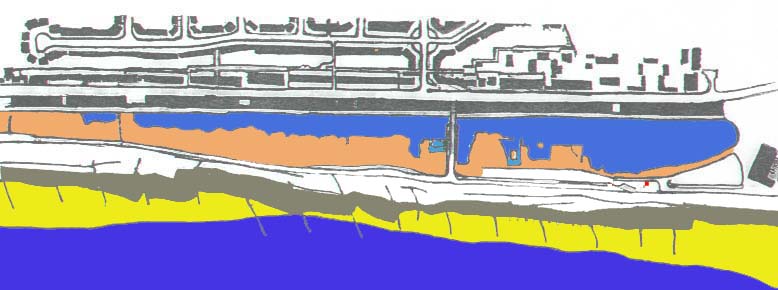
The specific gravity reading in the main channel was about 1.014 at 24° C which gives a salinity of about 23‰ (ppt) which is into the medium brackish range that could support cockles and other marine organisms. This represents a fall of 6‰ (ppt) from the previous reading in July 2002.
Tens of thousands of very small (> 15 mm) prawns collected on the lagoon edges amongst the pebbles. They were too small for positive identification with the naked eye, but I tend to go for the Common Prawn, Palaemon elegans.
In the surrounds of the causeway, I suddenly spotted a Ringed Plover chick. the two parents were conspicuous, part of their distraction behaviour, and altogether a small flock of about 15 Ringed Plovers wheeled noisily. Wheatears were flying around as well, prior to emigration and the Mute Swan couple were accompanied by nine dirty grey cygnets. The Little Egret seems to have deserted Widewater this summer after being a regular every day visitor, if not virtually a resident during he colder months.
A splendid large and distinctive example of a female Emperor Dragonfly buzzed overhead.
Adur Dragonflies13 August 2002
A really mixed back of wildlife in the morning from an immigrant Painted Lady Butterfly settled on a flower amongst a flutter of various smaller butterflies on Shoreham beach near the Church of the Good Shepherd, where further along towards Widewater at least a dozen Wheatears were preparing for their flight back to Africa.On Worthing beach several hundred Sand Gobies were present in the pools to the south of the pier which were covered on bedrock weed of sufficient variety to interest the phycologist.
Basking on the airport road outside of Ricardo's Engineering Works, a Common Lizard did not move as I cycled past. I stopped and tickled it under the chin and then it skittled into the undergrowth.12 August 2002
A low spring tide forecasted at 0.2 on WXTides at Kingston beach (Shoreham Harbour) receded past the tide marker for at least 20 minutes and the sand covered almost all the rocks.
Another Sting Winkle, Ocenebra erinacea, was recorded and one orange coloured Common Chiton, Leptochiton asellus. The chiton was fixed to the underside of rock at mid-tide level, amongst the loose rocks between the end of the groynes and the water line. This is the usual place where these small (16 mm) oval rock-hugging molluscs can be discovered, but they are not prevalent and can be easily overlooked.
One of the venerids (bivalve mollusc), probably Venerupis senegalensis (=pullastra) was still alive on the surface under a rock.
A large (20 mm) specimen of the distinctive small shrimp-like crustacean Athanas nitescens was blue with a white stripe down its back, looking formidable like a microscopic lobster, if it was not so tiny.
Fish List for the Trip8 August 2002
On a breezy sunny and still humid day, the butterflies on the old railway track south of the old Shoreham Toll Bridge included Painted Ladies (4+) possibly blown in from France, as well as the distinctive silhouettes of the Red Admirals (4+), a particularly bright orange of the Small Tortoiseshell Butterflies (4+), with Small Whites, Gatekeepers and Meadow Browns, all just a few.29-30 July 2002
The Daisy Anemone, Cereus pedunculatus, has been discovered by Paul Parsons off the outfall pipe near Brooklands boating lake. I (Andy Horton) have discovered this sea anemone (that contains symbiotic algae) on Worthing beach on one memorable occasion, but at the moment this seems the most easterly discovery of this sea anemone on the northern English Channel coast and shallow seas.
BMLSS Sea Anemones29 July 2002
It is very hot and humid with a temperature of 28.5° C was attained during the day, and even at midnight it is 21.7 ºC with a humidity of 81%.28 July 2002
To compare the butterflies on Mill Hill with the ones seen yesterday in the Lancing Clump meadows, I made a late afternoon visit and notes that the density in a smaller area was at least twice as high but the variety of butterflies, with just one pair of eyes, was smaller. Again in order of frequency, the butterflies are listed:
Gatekeeper (200+)
Meadow Brown (70+)
Marbled White (35+)
Small Skipper (25+)
Chalkhill Blue (15+)
Red Admiral
Large White
Small WhiteThere were hundreds of 6-Spot Burnet Moths in the long grasses.
The blue butterflies in the medium length grasses would not settle with their wings open, on the muggy humid day, and I could not instantly confirm their identification. It is in a known Chalkhill Blue habitat and the underside has an absence of any orange so it seems that Chalkhill Blue is probable.
Blue Butterflies (Photographs 2000)27 July 2002
Friends of Lancing Ring have arranged for expert Brianne Reeve of the Butterfly Conservation group to lead a walk over the reserve.On a hot (25° C) and muggy (humidity 86%) day, the walk produced an exceptional variety of butterflies. In order of prevalence these were:
Small Skipper
Meadow Brown
Gatekeeper
Marbled White
Holly Blue
Common Blue
Red Admiral
Large White
Small White
Wall Brown
Speckled Wood
Peacock
Large Skipper
Small Copper
Chalkhill BlueThe last two were rarities in the meadows. Both could have been overlooked by a single naturalist. Small red mites were present on some of the Meadow Browns.
6-Spot Burnet Moths was also common in the meadows.
Butterfly Walk in August 2001
Butterflies of Lancing
Adur Butterflies
Shermanbury Butterflies
UK-LEPS Discussion Group (for Butterflies and Moths)
ADUR VALLEY NATURE NOTES 2001 WINTER Nature Notes 2001 JANUARY - MARCH SPRING Nature Notes 2001 APRIL - JUNE SUMMER Nature Notes 2001 JULY - SEPTEMBER AUTUMN Nature Notes 2001 OCTOBER - DECEMBER
Lancing Nature News (June 2002)
(by Ray Hamblett)
- British
Web Sites
Dragonflies
of the Hampshire & Surrey Borders
Flight
Times (First Seen)
- Historical
Snippets
Weapon burials and the social context
The practice of inhumation with weapons is widespread, both temporally and geographically, among those peoples commonly referred to as Germanic. It seems to have begun in the late Roman empire, and has been seen as an attempt to reflect the barbarian Roman's status in death as well as in life. The rite partially supplanted, and in many cases continued alongside, the older rite of cremation, both finally dying out with the conversion to Christianity. Common assumptions that are made are that the weapon rite represents both the burial of a warrior and of a full set of fighting kit (or "Heregewede"). From this, the extrapolation of status, wealth and social categories has often been made. Pader has analysed Anglo-Saxon graves (largely female: on the whole they contain more gravegoods to analyse) on the basis of artefact distribution, both in the type and position, and found a complex structure of factors such as age, sex, position in the cemetery, and posture, which seem to influence gravegood distribution.
Military
hardware in local Saxon graves seems to be scarce; a shield boss
was found at Highdown
but although plenty of coins and brooches have been discovered, I do not
know of any swords, perhaps a few spearheads
etc. I have not looked into this thoroughly though.
An
Axe
Hammer was discovered at Alfriston.
Adur Valley Book List
- Words
of the Week
pinnate | pnet | a. E18. [L pinnatus, f. pinna, penna: see PINNA n.2, -ATE2.] 1 Bot. & Zool. Resembling a feather; having lateral parts or branches on each side of a common axis, like the vanes of a feather; having feather-like markings; (of a compound leaf) composed of a series of (usu. opposite) leaflets arranged on each side of a common petiole.
---------------------------------------------------------
Excerpted
from The Oxford Interactive Encyclopedia
Developed
by The Learning Company, Inc. Copyright (c) 1997 TLC Properties Inc.
Leaf shapes are arranged in a standard descriptive convention, see The Penguin Dictionary of Natural History, and other books.
Definitions:
Pinnate
With
leaflets arranged on opposite sides of a common stalk
Elliptic
Oval,
but acute at each end
Trifoliate
Having
three leaflets.
---------------------------------------------------------
Excerpted
from the Glossary of
The
Concise British Flora in Colour by W. Keble Martin
Publisher:
George Rainbird Limited 1965
The
Glossary contains a larger number of leaf shapes than the dictionary.
- Tucows
Software Reviews

|
Web
Monkey :
The Web Developer's Resource
Location:
http://hotwired.lycos.com/webmonkey/
Digital
Photography Review
http://www.dpreview.com/
The default files created
have the suffix *.html so anybody using the program has to be a little
bit cautious about overwriting existing files.
Computing
Net Support Site
(for computing problems) ****
http://computing.net/windows95/wwwboard/wwwboard.html
The upsurge of EFora
on all subjects (a
few have been recommended before in these bulletins) are an important way
in which the Internet
will change the world.
A list of recommended eFora
are shown in the left hand column. Please make any suggestions.
Smart
Groups
At
present almost all groups are receiving sustained attacks by spam mail
(junk mail) which is a serious nuisance.
Fight
Spam on the Internet
http://spam.abuse.net/
Literature
To a Skylark
by Percy Bysshe ShelleyHail to thee, blithe Spirit!
Bird thou never wert,
That from heaven, or near it,
Pourest thy full heart
In profuse strains of unpremeditated art.Higher still and higher
From the earth thou springest
Like a cloud of fire;
The blue deep thou wingest,
And singing still dost soar, and soaring ever singest.In the golden lightning
Of the sunken sun,
O'er which clouds are bright'ning,
Thou dost float and run,
Like an unbodied joy whose race is just begun.The pale purple even
Melts around thy flight;
Like a star of heaven
In the broad daylight
Thou art unseen, but yet I hear thy shrill delight -Keen as are the arrows
Of that silver sphere
Whose intense lamp narrows
In the white dawn clear
Until we hardly see -we feel that it is there.All the earth and air
With thy voice is loud,
As, when night is bare,
From one lonely cloud
The moon rains out her beams, and heaven is overflowed.What thou art we know not;
What is most like thee?
From rainbow clouds there flow not
Drops so bright to see
As from thy presence showers a rain of melody.Like a poet hidden
In the light of thought,
Singing hymns unbidden,
Till the world is wrought
To sympathy with hopes and fears it heeded not:Like a high-born maiden
In a palace tower,
Soothing her love-laden
Soul in secret hour
With music sweet as love, which overflows her bower:Like a glow-worm golden
In a dell of dew,
Scattering unbeholden
Its aerial hue
Among the flowers and grass, which screen it from the view:Like a rose embowered
In its own green leaves,
By warm winds deflowered,
Till the scent it gives
Makes faint with too much sweet these heavy-winged thieves:Sound of vernal showers
On the twinkling grass,
Rain-awakened flowers,
All that ever was
Joyous, and clear, and fresh, thy music doth surpass.Teach us, sprite or bird,
What sweet thoughts are thine:
I have never heard
Praise of love or wine
That panted forth a flood of rapture so divine.Chorus hymeneal
Or triumphal chaunt
Matched with thine would be all
But an empty vaunt -
A thing wherein we feel there is some hidden want.What objects are the fountains
Of thy happy strain?
What fields, or waves, or mountains?
What shapes of sky or plain?
What love of thine own kind? what ignorance of pain?With thy clear keen joyance
Languor cannot be:
Shadow of annoyance
Never came near thee:
Thou lovest, but ne'er knew love's sad satiety.Waking or asleep,
Thou of death must deem
Things more true and deep
Than we mortals dream,
Or how could thy notes flow in such a crystal stream?We look before and after,
And pine for what is not:
Our sincerest laughter
With some pain is fraught;
Our sweetest songs are those that tell of saddest thought.Yet if we could scorn
Hate, and pride, and fear;
If we were things born
Not to shed a tear,
I know not how thy joy we ever should come near.Better than all measures
Of delightful sound,
Better than all treasures
That in books are found,
Thy skill to poet were, thou scorner of the ground!Teach me half the gladness
That thy brain must know,
Such harmonious madness
From my lips would flow
The world should listen then, as I am listening now!
Image Gallery
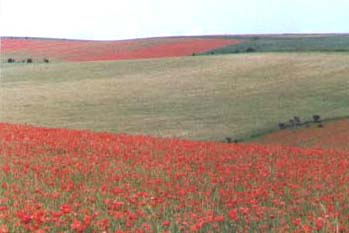
Poppies by Andy Horton
June 2002
On a pleasant sunny day after a generally inclement spring, it was nearly the solstice before I made my first eventful trip to Mill Hill. Most noticeable was the field of Common Poppies grazed by a dozen or so cows between Mill Hill and Buckingham Barn, and also bright red fields to the north-east and on the ridges, highest points of the downs.

Archaeology in Sussex to AD 1500 ****
WSCC
LIBRARY *****
Excellent
and essential service with a full catalogue of books, CDs, videos, on-line
renewals, book ordering.
- The
Glaucus 2000 CD-ROM includes the complete Shoreham-by-Sea
and Adur Valley web sites, as well as shareware
and free programs

ADUR VALLEY EFORUM PAGE |
Events
31 August 2002 & 1 September 2002
11:30 am 5:00 pm
BATTLE OF BRITAIN AIR SHOW
at Shoreham Airport
Second Saturday every month.
Farmer's Market
Fresh
produce
East
Street, Shoreham-by-Sea
- Adur
On-line Events page
- http://appspace.nexus-solutions.net/arc/asp/diary/diaryoutput.asp
- Please send in any details of local events.
- Web
Sites
American
Heritage Dictionary of the English Language:
Fourth
Edition *****
- SPONSORSHIP OPPORTUNITY
For any company or organisation wanting nationwide green publicity, there is an opportunity to sponsor the journal "Glaucus" of the British Marine Life Study Society.
There remains sponsorship opportunities on the BMLSS (England) web site and other publications, including Torpedo.
Sponsorship is also available for the Adur Torpedo Electronic News Bulletin and the Shoreham-by-Sea web pages (which preceded the Adur Resource Centre web site), which would be more suitable for a local firm(s).
Web Site Design Services are available from Hulkesmouth Publishing
Normal
advertisement rules apply.
Submissions
accepted by EMail only.
Adur Torpedo was written, designed and distributed by Andy Horton.

